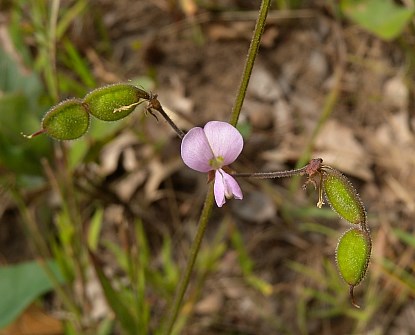Description: This perennial wildflower is 2–3½' tall, branching occasionally. The stems are medium green to brown and sparsely to densely covered with both hooked and straight hairs. Alternate compound leaves occur at intervals along these stems; the structure of the leaves is trifoliate. Each compound leaf has a hairy petiole up to ½" long; at the base of each petiole, there is a pair of tiny deciduous stipules that are linear-lanceolate in shape. Individual leaflets are up to 2½" long and 1¼" across; they are oval to narrowly oval in shape, smooth and slightly ciliate along their margins, and rough-textured. Their upper surfaces are medium green and sparsely covered with short stiff hairs, while their lower surfaces are light green and covered with similar hairs. The terminal leaflet is larger in size than the lateral leaflets; the lateral leaflets have very short petiolules (secondary petioles), while the petiolule of the terminal leaflet is up to ½" long.

The upper stems
terminate in either panicles or racemes of flowers about ½–1½' long and
about one-third as much across or less. The central stalk of a panicle
branches either oppositely or in whorls of 3. Both the central stalk
and its lateral branches (if any) are covered with hooked hairs.
Individual flowers occur on short pedicels up to ½" long. Each flower
is about ¼" long, consisting of 5 pink to rosy pink petals, a very
short tubular calyx that is toothed, an ovary with a single style, and
several stamens. The flower has a pea-like structure, consisting of an
upper banner and two lateral wings that enclose a lower keel. At the
base of the banner, there is a small patch of yellow. The blooming
period occurs from mid-summer to early fall and lasts about 1–1½
months. Fertile flowers are replaced by small loments (segmented flat
seedpods) about ½–¾" long. Each loment usually consists of 2-3
segments; the lower side of each segment is more rounded than the upper
side. Loments have very
short stipes and sometimes terminal beaks;
their sides are covered with hooked hairs. Each segment of a loment
contains a single seed. The root system consists of a narrow caudex
with fibrous roots. This wildflower reproduces by reseeding itself,
sometimes forming small colonies.
Cultivation:
The preference is partial sun, dry-mesic conditions, and sandy or rocky
soil. Nitrogen is added to the soil through a symbiotic association
between the root system and mycorrhizal bacteria.
Range & Habitat:
The native Obtuse-Leaved Tick Trefoil occurs in scattered locations in
southern,
western, and a few other areas in Illinois; it is uncommon within the
state. Illinois lies along the NW range limit of this species. Habitats
include open sandy woodlands, upland rocky woodlands, sandy savannas,
woodland edges, rocky glades, and powerline clearances in sandy or
rocky woodlands. Occasional wildfires or other disturbance tends to
increase populations of this wildflower in the preceding habitats.
Faunal Associations:
The flowers offer only pollen as a reward to insect visitors. These
floral visitors consist primarily of bumblebees (Bombus spp.),
long-horned
bees (Melissodes spp.),
and leaf-cutting bees (Megachile
spp.). Other
insects feed on the foliage, flowers, seedpods, or plant juices of Desmodium
spp. (Tick Trefoil species). These insect feeders include
such skipper caterpillars as Achalarus lyciades
(Hoary Edge), Thorybes bathyllus (Southern
Cloudywing), Thorybes pylades (Northern
Cloudywing), and Epargyreus clarus (Silver-Spotted
Skipper); caterpillars of the butterflies Everes comyntas
(Eastern Tailed Blue) and Strymon melinus
(Gray
Hairstreak) also feed on these plants. Other insects feeders include
primitive weevils (Brentidae), leaf beetles, larvae of gall flies,
larvae of leaf-blotch miner moths (Gracillariidae), grasshoppers,
aphids, and thrips (see the Insect Table for a more complete and detailed listing of these species). Among vertebrate
animals, the seeds are eaten by some upland gamebirds (Bobwhite, Wild
Turkey) and small rodents (White-Footed Mouse, Deer Mouse), while the
foliage is browsed by White-Tailed Deer and the Cottontail Rabbit. The
foliage is also palatable to cattle, horses, and sheep. The seedpods
cling readily to the fur of animals and the clothing of humans; as a
result, the seeds are distributed to new locations.
Photographic Location:
A sandy savanna at the Hooper Branch Savanna Nature Preserve in
Iroquois County, Illinois.

Comments: This is one of several Desmodium spp. (Tick Trefoil species) in Illinois. Many of these species are found in savannas and open woodlands; their small pinkish flowers are very similar to each other. Obtuse-Leaved Tick Trefoil has wider leaflets than most other species in this genus (about 2-3 times as long as they are wide). Other critical features for identification include the following: 1) the stipules are tiny and deciduous, 2) the loments usually consist of only 2-3 segments, 3) the segments of the loments are rounded on both sides, although more so on their lower sides than their upper sides, and 4) the leaflets are relatively large (up to 2½" long and 1¼" across) and rough-textured. Another common name of this species is Stiff Tick Trefoil, which is derived from an obsolete scientific name, Desmodium rigidum.